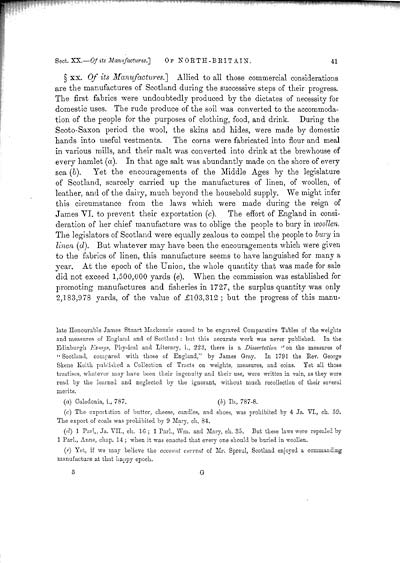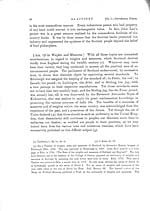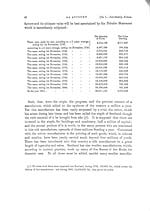Volume 3
(50) Page 41
Download files
Individual page:
Thumbnail gallery: Grid view | List view

41 � xx. Of its Manufactures.] Allied to all those commercial considerations are the manufactures of Scotland during the successive steps of their progress. The first fabrics were undoubtedly produced by the dictates of necessity for domestic uses. The rude produce of the soil was converted to the accommoda- tion of the people for the purposes of clothing, food, and drink. During the Scoto-Saxon period the wool, the skins and hides, were made by domestic hands into useful vestments. The corns were fabricated into flour and meal in various mills, and their malt was converted into drink at the brewhouse of every hamlet (a). In that age salt was abundantly made on the shore of every sea (b). Yet the encouragements of the Middle Ages by the legislature of Scotland, scarcely carried up the manufactures of linen, of woollen, of leather, and of the dairy, much beyond the household supply. We might infer this circumstance from the laws which were made during the reign of James VI. to prevent their exportation (c). The effort of England in consi- deration of her chief manufacture was to oblige the people to bury in woollen. The legislators of Scotland were equally zealous to compel the people to bury in linen (d). But whatever may have been the encouragements which were given to the fabrics of linen, this manufacture seems to have languished for many a year. At the epoch of the Union, the whole quantity that was made for sale did not exceed 1,500,000 yards (e). When the commission was established for promoting manufactures and fisheries in 1727, the surplus quantity was only 2,183,978 yards, of the value of �103,312 ; but the progress of this manu- late Honourable James Stuart Mackenzie caused to be engraved Comparative Tables of the weights and measures of England and of Scotland : but this accurate work was never published. In the Edinburgh Essays, Physical and Literary, i., 223, there is a Dissertation "on the measures of " Scotland, compared with those of England," by James Gray. In 1791 the Rev. George Skene Keith published a Collection of Tracts on weights, measures, and coins. Yet all those treatises, whatever may have been their ingenuity and their use, were written in vain, as they were read by the learned and neglected by the ignorant, without much recollection of their several merits. (a) Caledonia, i., 787. (ft) Ib., 787-8. (c) The exportation of butter, cheese, candles, and shoes, was prohibited by 4 Ja. VI., ch. 59. The export of coals was prohibited by 9 Mary, ch. 84. (d) 1 Par]., Ja. VII., ch. 1G ; 1 Parl., Wm. and Mary, ch. 35. But these laws were repealed by 1 Parl., Anne, chap. 14 ; when it was enacted that every one should be buried in woollen. (e) Yet, if we may believe the account current of Mr. Spreul, Scotland enjoyed a commanding manufacture at that happy epoch. 3 G
Set display mode to:
![]() Universal Viewer |
Universal Viewer | ![]() Mirador |
Large image | Transcription
Mirador |
Large image | Transcription
Images and transcriptions on this page, including medium image downloads, may be used under the Creative Commons Attribution 4.0 International Licence unless otherwise stated. ![]()
| Caledonia, or, An account, historical and topographic of North Britain from the most ancient to the present times > Volume 3 > (50) Page 41 |
|---|
| Permanent URL | https://digital.nls.uk/74528174 |
|---|---|
| Description | Of its manufactures |
| Description | Vol. III. |
|---|---|
| Attribution and copyright: |
|

